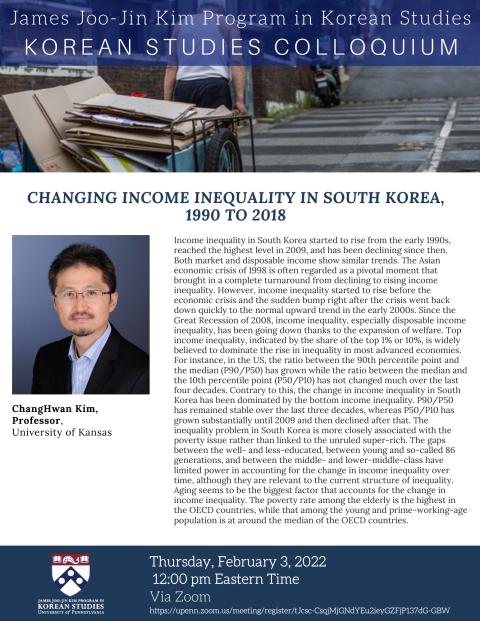
Korean Studies Colloquium
Via Zoom
REGISTER HERE
Income inequality in South Korea started to rise from the early 1990s, reached the highest level in 2009, and has been declining since then. Both market and disposable income show similar trends. The Asian economic crisis of 1998 is often regarded as a pivotal moment that brought in a complete turnaround from declining to rising income inequality. However, income inequality started to rise before the economic crisis and the sudden bump right after the crisis went back down quickly to the normal upward trend in the early 2000s. Since the Great Recession of 2008, income inequality, especially disposable income inequality, has been going down thanks to the expansion of welfare. Top income inequality, indicated by the share of the top 1% or 10%, is widely believed to dominate the rise in inequality in most advanced economies. For instance, in the US, the ratio between the 90th percentile point and the median (P90/P50) has grown while the ratio between the median and the 10th percentile point (P50/P10) has not changed much over the last four decades. Contrary to this, the change in income inequality in South Korea has been dominated by the bottom income inequality. P90/P50 has remained stable over the last three decades, whereas P50/P10 has grown substantially until 2009 and then declined after that. The inequality problem in South Korea is more closely associated with the poverty issue rather than linked to the unruled super-rich. The gaps between the well- and less-educated, between young and so-called 86 generations, and between the middle- and lower-middle-class have limited power in accounting for the change in income inequality over time, although they are relevant to the current structure of inequality. Aging seems to be the biggest factor that accounts for the change in income inequality. The poverty rate among the elderly is the highest in the OECD countries, while that among the young and prime-working-age population is at around the median of the OECD countries.
ChangHwan Kim is a professor of sociology at the University of Kansas. His main research areas include labor markets, stratification, education, Korean studies, Asian American studies, and quantitative methodology. His works appeared in American Sociological Review, Social Forces, Demography, and Korean Journal of Sociology among other outlets.
 James Joo-Jin Kim Center for Korean Studies
James Joo-Jin Kim Center for Korean Studies